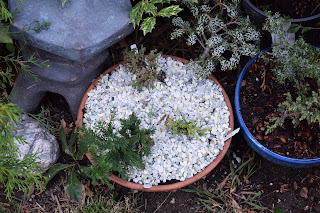Hard to believe it's already December, though the cold weather this last few days has driven that point home. Still, for those of us who have an all season garden, there's always something of interest. In that light, here are some photos of the garden taken last Thursday. As is often the case, this season is more about the foliage and less about the flowers.
Salvia regla Huntington Gardens. This new salvia offers bright reddish-orange flowers. It is new from a 4" container so we'll see how it fills out.
Black lotus. This small bush blooms nearly year round in my Oakland garden. The tiny burgundy pea-like flowers are always a delight.
My walkways bed is still showing some color, with three different varieties of Agastache in bloom plus the cheerful yellow and purple violas. It soon will explode in color with spring blooming bulbs.
I have a few late blooming Mimulus to cheer me up, like this M. Jelly Bean Gold. The Jelly Bean series especially seem to offer a long blooming season.
Erica canaliculata Rosea. I love heathers and this upright variety hailing from South Africa is a real charmer. I'm not sure about its true blooming season but it's in bloom now in its first year in my garden.
I practice layered planting, especially given how many bulbs I have in my garden. Here ground level violas keep company with my Cunonia capensis shrub.
Though not the best photograph, here's a few orangish flowers from my Justicia fulvicoma. It is a late fall bloomer and is even later this year. I love the 'plume' flowers as Justicias are sometimes called.
Those tiny curled 'fingers' you see here are the flowers on my Hamamelis intermedia, better known as Witch Hazel. It's normally not cold enough for the shrubs to do well here in Oakland but this year I'm getting a nice bumper crop of fragrant flowers.
Here are two of my mixed, bonzai, dwarf conifer bowls, one with white stone for dramatic contrast and the other left with plain soil.
This is my original dwarf conifer bowl, which has become visually dominated by the golden Chamaecyparis there.
I have begun filling up the front of what once was entirely an Australian natives bed with various succulents and dry garden plants. Over time it's made for a nice show, both for my neighbors and any passersby that love gardens.
Cistus 'McGuire's Gold.' Though it hasn't flowered yet, this golden-leaved rockrose has provided plenty of colorful foliage.
Ficinia truncata 'Ice Crystal.' I'd never heard of this mat forming South African plant when I came across it at our nursery. Very unusual and charming. It will eventually produce golden-brown flowers on foot tall stems.
My Marmalade bush has finally filled out and resumed blooming, after a severe pruning two years ago. There's nothing quite like its collection of peachy-orange flowers.
If you recognize this as a staghorn fern you're half right. It is a Platycerium but this is P. veitchii, a slightly more silvery species that prefers sun over mostly shade.
My Helleborus argutifolius Pacific Frost has decided to get an early start on its blooming, here producing its first flowering spike of the new season. Although not obvious from this photo, this variety is so named because of the prominent white speckling on its leaves.
Though they are common, cyclamen are still a most welcome flower to any winter garden.
Rhipsalis variety. I've long ago lost the tag for this Rhipsalis but it has proven very hardy and even blooms on a regular basis. Mind you that's tiny white flowers that you barely notice but that's okay. It's the 'leaves' that are of interest to me. (and many others).
Kudos to those who can guess the identity of this, the newest addition to my garden. A picture of its showy reddish-orange flowers would be of a great help. It's a Stenocarpus sinuatus, better known as Firewheel tree. Though you wouldn't at first think so, it's a member of the Protea family and as far as we know, this genus has but one species. They can get huge in the wild - up to 100' tall - but more likely here in our cooler temperate climate 40-50'. I'm keeping mine in a pot and hope to keep it to a more manageable 20-30'.
Not sure how Nandina domestica ever got its common name (Heavenly bamboo) but it has proved a durable (and beautiful) shrub in my garden.
If Farfugium doesn't ring a bell as this plant's genus, then how about Ligularia? Yep, the powers-that-be have reclassified many of the plants in this genus as belonging to Farfugium. In this case, it's a F. japonica Aureomaculatum. Though it does produce yellow flowers, most people grow this shade-loving plant for its foliage. It is a bit susceptible to being eaten by snails, as you can see here (before I got the snail bait out).
Microlepia strigosa (Lace fern). One of my favorite ferns and so far so good with it avoiding getting thrips.
Subscribe to:
Post Comments (Atom)























No comments:
Post a Comment